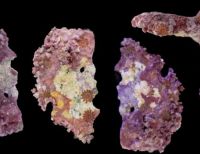
Deposits from the Sturtian Glaciation 717–664 million years ago in the northern Flinders Ranges, Australia. Research lead author Dr Adriana Dutkiewicz pointing to a thick bed of glacial deposits. Photo: Professor Dietmar Müller/University of Sydney
Australian geologists have used plate tectonic modelling to determine what most likely caused an extreme ice-age climate in Earth’s history, more than 700 million years ago.
The study, published in Geology, helps our understanding of the functioning of the Earth's built-in thermostat that prevents the Earth from getting stuck in overheating mode. It also shows how sensitive global climate is to atmospheric carbon concentration.
“Imagine the Earth almost completely frozen over,” said the study’s lead author, ARC Future Fellow Dr Adriana Dutkiewicz. “That’s just what happened about 700 million years ago; the planet was blanketed in ice from poles to equator and temperatures plunged. However, just what caused this has been an open question.
“We now think we have cracked the mystery: historically low volcanic carbon dioxide emissions, aided by weathering of a large pile of volcanic rocks in what is now Canada; a process that absorbs atmospheric carbon dioxide.”
The project was inspired by the glacial debris left by the ancient glaciation from this period that can be spectacularly observed in the Flinders Ranges in South Australia.
A recent geological field trip to the Ranges, led by co-author Professor Alan Collins from the University of Adelaide, prompted the team to use the University of Sydney EarthByte computer models to investigate the cause and the exceptionally long duration of this ice age.
The extended ice age, also called the Sturtian glaciation after the 19th century European colonial explorer of central Australia, Charles Sturt, stretched from 717 to 660 million years ago, a period well before the dinosaurs and complex plant life on land existed.
















